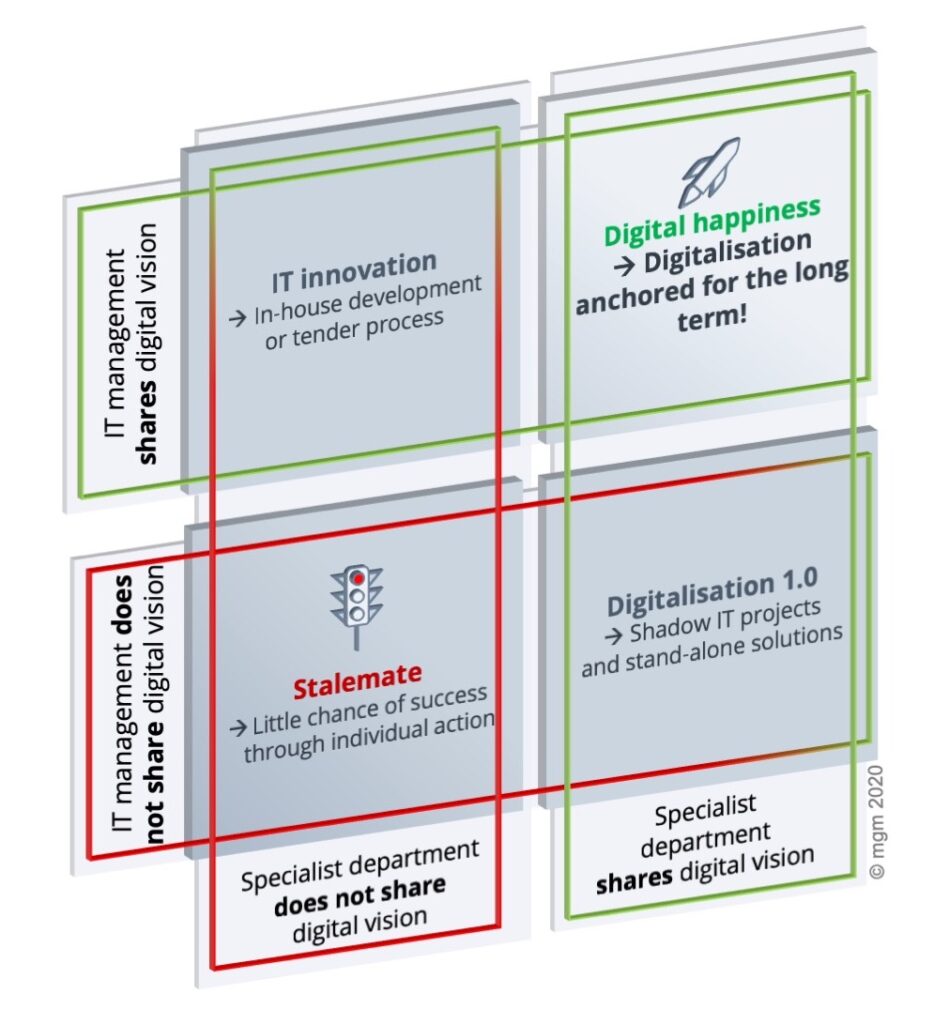
The rise of digitalisation has come at a bad time for industrial insurance providers. Managers and employees at many companies are still licking their wounds following previous IT projects to modernise their core systems. Quite apart from these issues, these are challenging times for the insurance industry as a whole. As a result, despite the enthusiasm for one-off digital projects such as blockchain-based projects and online portals, insurance providers are not developing a coherent, sustainable vision for interweaving digitalisation into their corporate DNA.
However, in order to adopt an adequate strategic approach to digitalisation at last, companies must examine in detail the short-term and medium-term benefits they hope it will bring.
In the industrial insurance sector, digitalisation threatens to remain a topic for IT departments alone. Either that, or the digitalisation process will remain something of a subject-specific submarine, staying under the radar and surfacing opportunistically without effecting any company-wide impact. This is obviously a mistake – and one we see time and again. Given the topic’s dislocation from day-to-day operations, it is understandable that the reflex of many managers is to once again hide digitalisation away in the IT box. However, in order to adopt an adequate strategic approach to digitalisation at last, companies must examine in detail the short-term and medium-term benefits they hope it will bring.
Innovative and competitive ability lies in specialist areas
Nowadays, specialist departments are tasked with conceiving of and developing coverage concepts. Consequently, individual departments are responsible for a proportion of a company’s ability to innovate and compete. They also take care of the majority of day-to-day communication with the market, primarily in the form of specialist collaborative processes such as product design, risk assessment, tender preparation and contract renewal.
In modern IT system environments, however, industrial products are often only depicted in rudimentary terms, with premiums, main limits, a distribution plan and a reference to the underlying wording. Key aspects such as risk information, cover models with specific guarantees, special agreements and so on are still only available in (digital) paper form – meaning that they are not always usable company-wide and are a long way from facilitating machine readability.
Questions of principle on digitalisation
This throws up a handful of interesting aspects and queries for the digital age:
- Sovereignty: What share of value creation should specialist departments shoulder in the context of creating digital products and processes?
- Product understanding: What is the vision for the substantive scope of digital products and their fields of application?
- Complexity: It is certainly tempting to seek to transfer the simplicity of consumer business to the industrial sector. But does that idea fit with the reality?
- Market overview and collaboration-based model: What technologies and solutions are available and how do they differ from each other? How do I want to collaborate with external partners – or do I want to collaborate with them at all?
- Change management: How well suited is the team to taking on these new duties? Will the organisation be able to handle it?
- Competition: What exactly is the situation with individual market partners with whom data is exchanged on a daily basis?
Companies often lack the necessary knowledge and experience and have little idea of the complexity of the concepts involved.
In many cases, it is not possible to have an informed discussion about these issues. Companies often lack the necessary knowledge and experience and have little idea of the complexity of the concepts involved. That is not a bad thing, so long as they acknowledge it. Instead, it provides an opportunity for an internal dialogue at eye level; it facilitates a discussion between technically focused entrepreneurs and those in specialist departments within the company. Plus, it can take place without any external support. It is vital to define the objective – namely creating a shared vision of the company’s digitalised future – from within the company.
Far too often, however, new ideas fall apart because before there is a joint discussion and analysis of the substance of a topic, it is swept aside and handed over to the IT department, where a call for tenders is quickly drawn up. That is not the right approach. At worst, when a vision has not been fully developed, it turns into questions – such as: “Is your system capable of distinguishing between mandatory and optional fields?”
In and of itself, digitalisation does not deliver a competitive advantage
Granted, digitalisation does fulfil its role of accelerating processes and reducing costs in the short term. However, such changes will not necessarily yield a competitive advantage. In the first phases of digitalisation, and in addition to the aforementioned aspects, a primary focus is laying the foundations for future stages of innovation that were not known to begin with. These typically arise from the continuous and assiduous analysis and ongoing development of service offerings.
Let’s look at a hypothetical example from the insurance sector to illustrate this ongoing process. The insurance provider Inleyo would like to establish a digital connection with its brokers. It therefore establishes an online portal that includes the functionality to offer quotations, documentation and renewals for an innovative product group. After three months in operation, the new digital channel is performing below average. In a series of conversations, the insurance provider identifies that its brokers and clients do not yet have the expertise needed to explain quotations to customers. As a result, they have not been seeking to speak with customers directly. The digitalisation team finds a way to produce a video completely automatically in the portal once a quotation has been requested, explaining the quotation to the customer based on the data they provided. The insurance provider gives its partners the option of speaking with an expert directly via video chat in order to address any specific questions.
In the following renewal season, the Inleyo team loses a few clients – and, when examining the causes of this, discovers that a competitor had introduced a collaborative digital process with its clients for the registration process. This service makes inspection visits redundant and, in the context of the coronavirus pandemic, has become a key sales and service argument, delivering a directly positive customer experience. The Inleyo team therefore re-prioritises its agile roadmap for the next quarter in order to offer a similar service of its own.
The axes of digital (un)happiness
It is thus important to anchor the topic in the agenda for the long term to ensure that companies can systematically seize competitive advantages.
We can see, then, that digitalisation is not a project with a defined endpoint but rather a permanent state of change. It is thus important to anchor the topic in the agenda for the long term to ensure that companies can systematically seize competitive advantages. In order for this long-term anchoring to function, and for joint specialist and technical teams to prove themselves, there must be a top-down commitment to this new way of working. Committing to work in this way ultimately makes it possible for the digital transformation to deliver happiness.
From our subjective observations, we have been able to identify four clear patterns in relation to digitalisation in the industrial insurance sector (see graphic):
- Digital happiness: A medium-sized business identified that the number of paper-based and manual procedures still in place was crazy. Management was and remains fully informed and integrated, and is a driver of change – moving towards fully digital working throughout the company’s entire portfolio and in all segments. One example of this commitment is the fact that management was actively represented in every sprint review.
- An IT project leading onto the road to digital happiness: In a medium-sized market player, the digitalisation process began as an IT project because the systems in place had reached the end of their service lives. During this project, staff working on the project noticed that not all departments within the organisation were integrated in the redesign process. After re-examining the project realities, the company restructured its collaboration model and introduced a supporting visualisation of its objectives in its daily operations. Thus began a process to establish an integrative digitalisation initiative.
- The submarine that never surfaces: A large market player launches a market-oriented and successful digitalisation initiative, but without integrating its IT department. After a few years, the management board decides on an in-house development.
- The IT system that is not accepted: A company’s IT department develops a specific platform of its own accord. However, not all specialist departments accept the platform and the project is put on hold. Stalemate!
In summary, it is our experience that an initiative is only of interest when the management board, specialist departments and the IT department all support a digital project to form a critical mass. I am very much aware of how banal this statement sounds. An important element in keeping everyone on task is defining a common objective. This objective should be comprehensible, brought to life and communicated to everyone.
The major challenge: Objectifying abstract digitalisation fantasies
As soon as a company has given form to its vision of digitalisation, it must be outlined to everyone in a comprehensible manner. One potential starting point would be to select a core process and create a target image to illustrate how this process should ultimately look – according to the current vision. Examples include premium statements, product design, processing international programmes and renewals.
Management boards come and go, but it is essential that digitalisation and new platforms endure for longer. Only then will they be able to deliver the desired added value
A correct internal constitution would then also include self-awareness on the part of top managers that, in contrast to digitalisation, their days in the company are numbered. Management boards come and go, but it is essential that digitalisation and new platforms endure for longer. Only then will they be able to deliver the desired added value. It is therefore important that, when it comes to digitalisation, management boards are able to make abstract digitalisation fantasies objectifiable, take decisions on this basis, and thus ensure operational continuity.
This text first appeared here in “Herbert Frommes VERSICHERUNGSMONITOR” (paid) in January 2021.
Photo by David Marcu on Unsplash



Neueste Kommentare